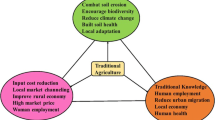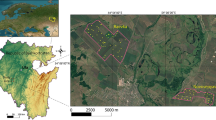Abstract
In the Mamlay watershed of south Sikkim, India, about 80% of the population depend on land for their livelihood. The agricultural land-use activity includes agroforestry, horticulture and animal husbandry besides growing crops in irrigated or unirrigated fields. Trees are maintained in the farms mainly for fodder and rarely for fuel purposes. Cropping system is characterised by cultivation of cereals and cash crops to ensure supply of food grains and returns for daily needs. This paper presents data on crop production and farm management aspects including the linkages among tree-crop-animal components of a hill agriculture system. Crop diversity is high and crop combinations are fixed and well tested. Unpalatable grasses are used for composting by mixing with cow dung to meet high demand for manure and thus exhibit efficient recycling of plant material. The system is at low input level, and is therefore adopted by even the poorest section of society. Limited infrastructure facilities, sloping terrain, inaccessibility to most agricultural zone, depletion of natural resources from forests, water scarcity during lean period and heavy rainfall during monsoon, and erosion are, the main constraints which need to be improved through research using scientific means.
Similar content being viewed by others
References
Agriculture Census (1980–81) State report on agriculture census 1980–81 (Vol I). Agricultural census unit, Bhanupath, Government of Sikkim, Gangtok
Allen SE (1989) Chemical Analysis of Ecological Materials (2nd ed). Blackwell Scientific Publications. London
Awasthi RP and Prasad RN (1987) The role of cropping system in the increasing food production under rainfed agricultural systems of north-eastern hill regions of India. In: Proceedings of the seminar on rainfed agriculture in the Himalayan regions of India, pp 160–176. Pantnagar University, Pantnagar
Fonzen PF and Oberholzer, E (1984) Use of multipurpose trees in hill farming system in western Nepal. Agroforestry Systems 2: 187–197
Gangwar AK and Ramakrishnan PS (1989) Cultivation and use of lesser-known plants of food value by tribals in north-east India. Agric Ecosyst Environ 25: 253–267
Misra BK and Ramakrishnan PS (1982) Energy flow through a village ecosystem with slash and burn agriculture in north-eastern India. Agricultural Systems 9: 57–72
Nair PKR (1985) Classification of agroforestry systems. Agroforestry Systems 3: 97–128
Nair PKR (1987) Agroforestry systems inventory. Agroforestry Systems 5: 301–317
Piper CS (1950) Soil and Plant Analysis, Inter Science Publishers, New York
Planning Commission (1989) Agro-climatic regional planning: an overview. Planning Commission, Government of India, New Delhi
Ralhan PK, Negi GCS and Singh SP (1991) Structure and function of the agroforestry system in Pithoragarh district of central Himalaya: an ecological viewpoint. Agric Ecosyst Environ 35: 283–296
Shah SL (1982) Ecological degradation and future of agriculture in the Himalyas. Indian Agric Economics 37(1): 1–22
Sharma E and Ambasht RS (1988) Nitrogen accretion, and its energetics in the Himalayan alder. Functional Ecol 2: 229–235
Sharma E, Sundriyal RC, Rai SC, Bhatt YK, Rai LK, Sharma R and Rai YK (1992) Integrated Watershed Management: A Case Study in Sikkim Himalaya. Gyanodaya Prakashan. Nainital, 120 pp
Sharma S (1991) Energy budget studies of some multiple cropping patterns of the central Himalaya. Agric Ecosyst Environ 36: 199–206
Singh JS, Pandey U and Tiwari AK (1984) Man and Forests: a central Himalayan case study. Ambio 12(2): 80–87
Singh KA, Rai RN, Patiram and Bhutia DT (1989) Large cardamon (Amomum subulatum Roxb.) plantation: an age old agroforestry system in the eastern Himalayas. Agroforestry Systems 9: 241–257
Subba JR (1984) Agriculture in the Hills of Sikkim.. Sikkim, Science Society, Gangtok
Sundriyal RC, Sharma E, Rai LK and Rai SC (1994) Tree structure, regeneration and woody biomass removal in a sub-tropical forest of Mamalay watershed in the Sikkim Himalaya. Vegetatio (in press)
Toky OP and Ramakrishnan PS (1981) Cropping and yields in agricultural systems of the northeastern hill region of India. Agro-Ecosystems 7: 11–25
Author information
Authors and Affiliations
Rights and permissions
About this article
Cite this article
Sundriyal, R.C., Rai, S.C., Sharma, E. et al. Hill agroforestry systems in south Sikkim, India. Agroforest Syst 26, 215–235 (1994). https://doi.org/10.1007/BF00711212
Issue Date:
DOI: https://doi.org/10.1007/BF00711212




